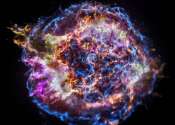Supernova surprise creates elemental mystery
Michigan State University (MSU) researchers have discovered that one of the most important reactions in the universe can get a huge and unexpected boost inside exploding stars known as supernovae.

Michigan State University (MSU) researchers have discovered that one of the most important reactions in the universe can get a huge and unexpected boost inside exploding stars known as supernovae.
General Physics
Dec 2, 2020
6
3471

The NOvA experiment, best known for its measurements of neutrino oscillations using particle beams from Fermilab accelerators, has been turning its eyes to the skies, examining phenomena ranging from supernovae to magnetic ...
General Physics
Nov 9, 2020
0
9

A new facility that could pave the way for a future generation of particle colliders and powerful light sources has turned on at the Department of Energy's SLAC National Accelerator Laboratory. Operating as a DOE user facility, ...
General Physics
Oct 13, 2020
0
54

Particle accelerators generate high-energy beams of electrons, protons and ions for a wide range of applications, including particle colliders that shed light on nature's subatomic components, X-ray lasers that film atoms ...
General Physics
Sep 24, 2020
2
615

Place a charged particle in an electromagnetic field and the particle will accelerate and give off radiation. Typically, the emitted radiation has little effect on the particle's motion. However, if the acceleration is extremely ...
General Physics
Sep 23, 2020
0
120

Scientists at the Department of Energy's Oak Ridge National Laboratory and the University of Nebraska have developed an easier way to generate electrons for nanoscale imaging and sensing, providing a useful new tool for material ...
Optics & Photonics
Sep 14, 2020
0
73

In a recent report, Xiaolei Peng and a team of scientists in materials science and engineering at the University of Texas, U.S., and the Tsinghua University, China, developed opto-thermoelectric microswimmers bioinspired ...

In science fiction, firing powerful lasers looks easy—the Death Star can just send destructive power hurtling through space as a tight beam. But in reality, once a powerful laser has been fired, care must be taken to ensure ...
Optics & Photonics
Aug 21, 2020
0
207

During the International Conference on High-Energy Physics (ICHEP 2020), the ATLAS collaboration presented the first observation of photon collisions producing pairs of W bosons, elementary particles that carry the weak force, ...
General Physics
Aug 5, 2020
1
1386

In 1820, Hans Christian Oersted gave a demonstration on electricity to a class of advanced students at the University of Copenhagen in Denmark. Using an early battery prototype, he looked to see what effect an electric current ...
General Physics
Mar 20, 2020
0
508